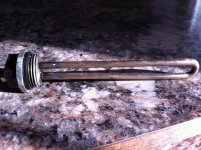I've just finished winterizing our Prowler and after removing the Anode rod I found the tank with about an inch of white sediment. I have pulled a hot water plug many times but this is a first. Often there is some sediment in the water, but not built up like this. Could this be because we spent three months in Tuscon last winter? In the past we have moved around. Last year we stayed put.
Also, how do I get ride of it? Can I just blast it out with a stream of water? Any help would be appreciated.
BTW, what a dream to winterize my Heartland trailer. I've scrambled under our Keystone Zeppelin and our KZ Spree and got wet, etc. The Prowler was veery easy.
Ted
Also, how do I get ride of it? Can I just blast it out with a stream of water? Any help would be appreciated.
BTW, what a dream to winterize my Heartland trailer. I've scrambled under our Keystone Zeppelin and our KZ Spree and got wet, etc. The Prowler was veery easy.
Ted










